Menu
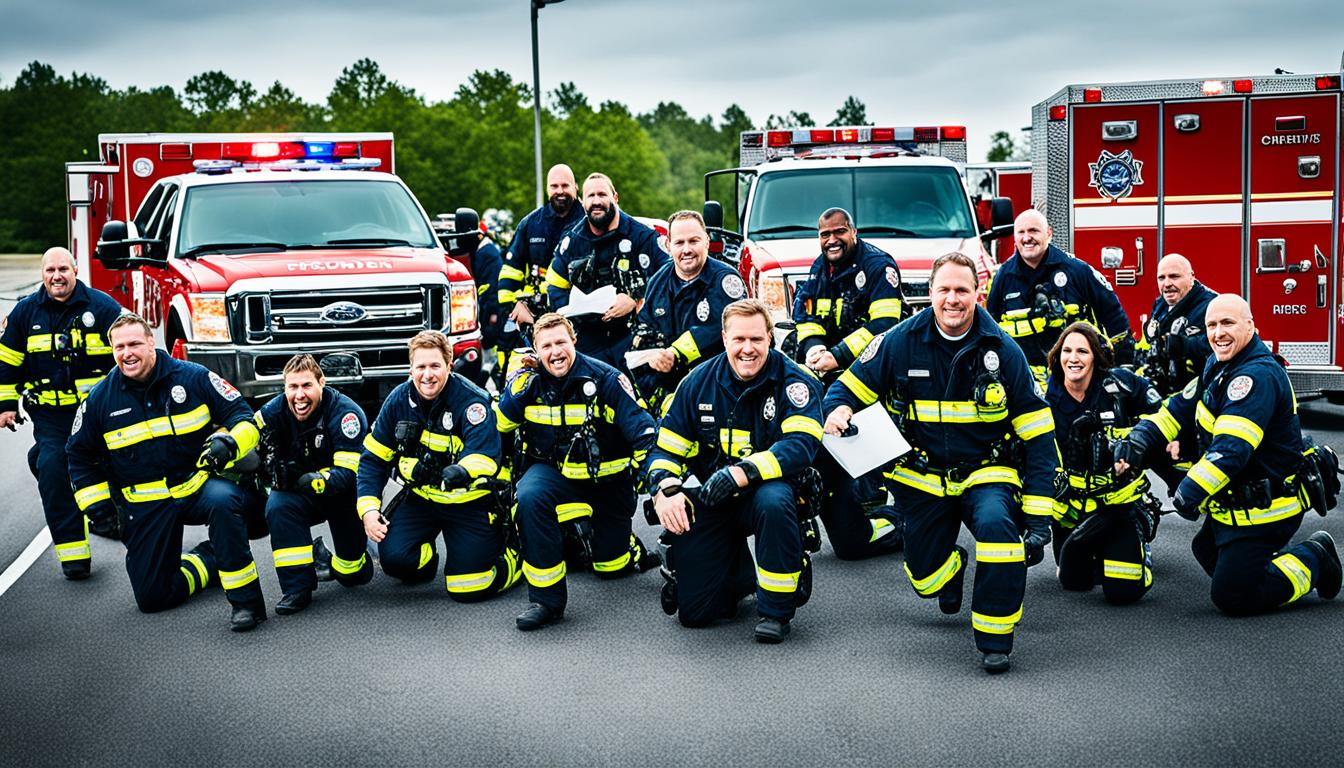
In real-life emergencies, up to 30 or more different groups work together. This shows us how complex and vital it is to work closely with local services. Good teamwork in emergency responses helps save lives and rebuild areas hit by disasters.
Using platforms like WebEOC makes communication smooth in crises. It quickly shares important information with services, making the response more efficient. During Hurricane Katrina, such systems showed their importance in helping manage the emergency effectively. WebEOC acts as a central hub, ensuring everyone talks and works together during a crisis, making communities stronger.
Ron Juarez, a professional at Juvare, highlights the value of tech in coordinating critical services. It makes sharing data and making vital decisions faster, which boosts how fast services can return to normal after an emergency. To make sure emergency services click into action without delay, set up communication systems in advance to support quick, smart choices when time is of the essence.
Coordination is key in emergencies, helping responders act quickly and correctly. Good local first responder partnerships and community safety strategies rely on solid plans. When utility companies and emergency services work together smoothly, it can greatly improve the situation.
Events like Hurricane Katrina show how vital good communication is. Such disasters call for close work with local emergency providers to handle the situation efficiently. Tools such as WebEOC help different agencies share important updates fast.
Emergency departments link with many other groups, usually 10 to 30. Without these links, sharing essential information can go wrong, making the response less effective. WebEOC fixes this by bringing all the information together, making talks quicker and smoother.
Effective coordination helps in managing resources and making decisions. In a hurricane, how two nursing homes were treated illustrated this point. Those at the forefront of coordination were better at distributing resources, saving both lives and properties.
This kind of teamwork does more than help single groups. It also bolsters community safety strategies, making everyone safer. By working together and having strong communication, emergency actions become united and more effective. This unity makes us all better prepared for what may come.
To learn more about the importance of a coordinated emergency response, visit this comprehensive resource by Juvare.
Effective emergency response needs many partners working together seamlessly. They improve planning, risk assessment, communication, and recovery. Here are some crucial partners in emergency response.
Local government agencies are vital in responding to emergencies. They involve managers, medical staff, and more. In Greenbrier County, West Virginia, for COVID-19, a task force brought together leaders in health, emergency management, and more. They had agreements to work together effectively.
Non-profits help a lot in emergencies, doing things like giving out supplies and helping with mental health. In Grundy County, Illinois, after a battery fire, the Community Foundation helped by giving money, finding places to stay, and offering support. Working with these groups makes a big difference, especially in towns.
It’s key to include businesses in emergency plans, but they need training. During COVID-19, local businesses helped by making and giving out important goods. FEMA says public-private partnerships are crucial for good emergency management. These partnerships help get resources quickly, making responses better.
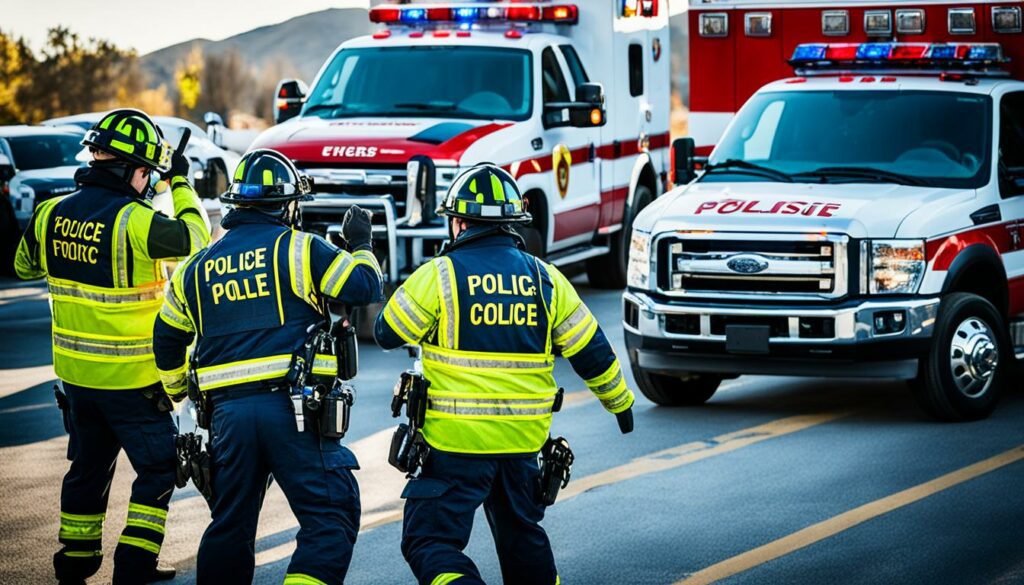
| Type of Partner | Roles and Responsibilities | Example |
|---|---|---|
| Local Government Agencies | Risk assessments, emergency management, public health coordination | Greenbrier County COVID-19 Task Force |
| Non-Profit Organisations | Supply delivery, psychological support, financial assistance | Community Foundation of Grundy County |
| Business and Private Sector | Provision of essential supplies, resource mobilisation | Local businesses supplying PPE during COVID-19 |
Strong data and communication are key for a good emergency response. They help make quick decisions and join different groups together smoothly. Platforms like WebEOC make sharing info in real-time much better. This improves how local emergency teams and others work together.
In 2019, the NECP explained how crucial data is in managing emergencies together. By working with states and territories, CISA ensures everyone’s communication plans match up. SWICs are important here, making sure data sharing boosts our ability to react at all levels.
SWICs help set up communication plans at the NCSWIC. Thanks to services like GETS, WPS, and TSP, emergency workers can always get through to each other. Even when networks are busy, these services keep crucial lines open, showing how vital teamwork is in managing crises.
MERS units and Mobile Communication Offices are ready to go, helping all through a crisis. They ensure quick sharing of info and connection to FEMA’s network. This means those in need can get help as fast as possible.
Also, working closely with federal partners for better communication in tough spots is key. Checking if local systems can keep working through crises, as the NECP advises, is crucial. This keeps us ready and strong for whatever emergencies come our way.
Effective teamwork between various groups is key in strong emergency responses. It needs input from many agencies and others. Using joint training and MOUs can really boost safety in our communities.
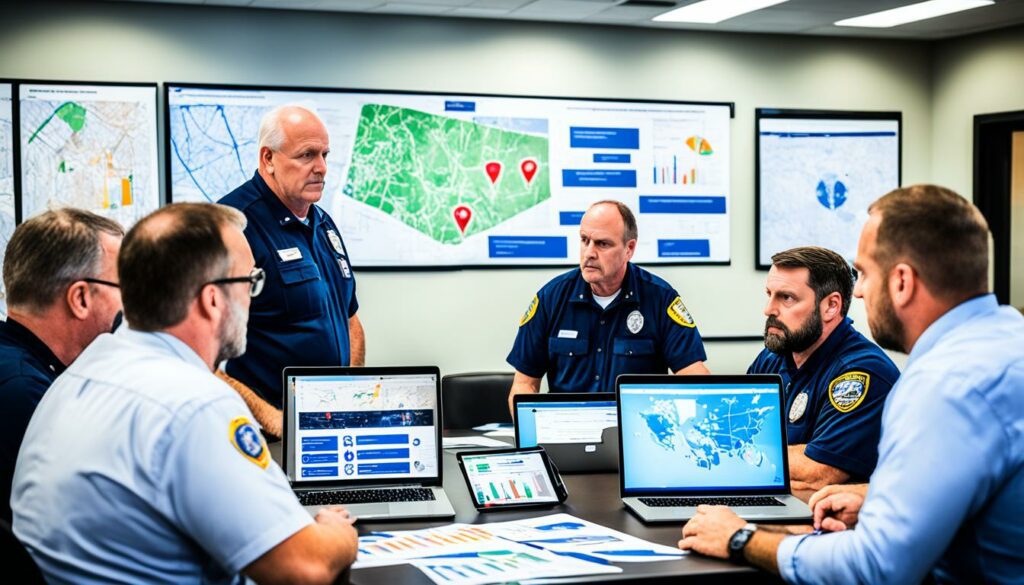
Joint training helps different groups work well together. It lets local health departments, schools, and rescue teams act as one. These exercises often include simulations of crises like natural disasters. The skills learnt can help save lives in actual emergencies. For instance, 750 health departments joining such drills had a 21.2% better response.
Signing MOUs makes sure everyone knows what they should do. They have helped health departments and schools prepare together. Because schools have many students and staff, being ready is very important for their safety.
Important people from emergency response, schools, and communities must work on emergency plans together. They should be trained in NIMS principles for better teamwork. By sharing information well, different groups can prepare for emergencies effectively.
Boosting community safety means working together using smart plans. This shows us how important it is to get ready and face emergencies as one.
Being ready for emergencies is a big part of managing risks well. There are mainly two types of emergencies – natural disasters and those caused by people. To handle these, everyone must know their role and work together.
Natural events like storms, floods, or earthquakes happen often in the U.S. They can severely affect areas and strain local resources. To deal with them, we need to do things before, during, and after they hit.
Before a disaster, making buildings stronger and having plans in place really help. When something does happen, people rush to help find others or keep everyone safe. After the danger passes, the focus moves to fixing things, making them stronger, and looking after the mental health of those affected.
Dangers from technology or terrorism bring their own set of challenges. In these cases, getting different groups to work together is key. They need to practice and know what to do to keep everyone safe.
During these emergencies, quick and well-coordinated actions are crucial. This can help save lives and lower the damage. Good communication and sharing information are vital for a successful response.
Emerging technologies have changed how we handle emergencies, making it easier and better. Emergency Operations Centres (EOCs) are a big step forward. They are the main place for organising and deciding what to do in a crisis. By using technology, they make sure everything runs smoothly and helps different groups work together better.
Emergency Operations Centres are really important for working with others during emergencies. They use the latest tools and systems to know what’s happening in real time, share information, and assign needed resources. They use Geographic Information Systems (GIS) for all parts of emergency management. For example, during the 2021 wildfires in the United States, GIS let responders track the fire’s movement. This helped with evacuation plans and where to put resources.
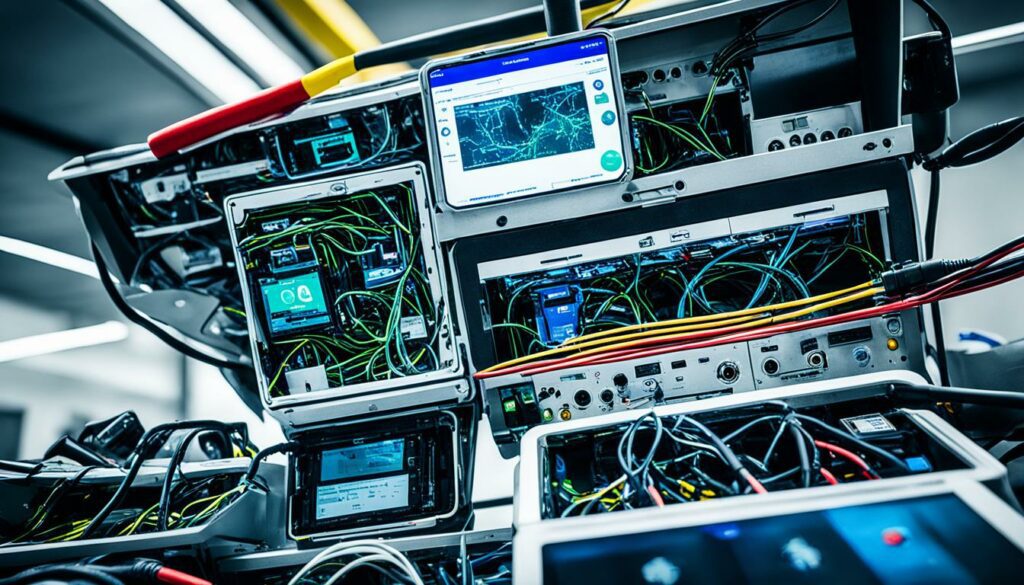
Good communication is key for emergency services to work together smoothly. Everyone, from local police to big federal agencies, must be able to talk easily. Smartphones are an example. They must now give you access to 911, even without a SIM card. FEMA’s app also helps by giving weather updates, finding emergency shelters, and signing up for disaster aid.
During the 2019-20 bushfires in Australia, advanced technology like Havrion HUB and facial recognition made a big difference. They helped send alerts to first responders quickly and check who the survivors were. This made the emergency response faster and more organised.
| Technology | Application | Impact |
|---|---|---|
| Geographic Information Systems (GIS) | Mapping and predicting disaster patterns | Improved situational awareness and resource deployment |
| Smartphones | Access to 911 and emergency services | Enhanced public safety and communication |
| Havrion HUB | Centralised notifications to first responders | Quicker response and compliance with protocols |
| Facial Recognition Software | Validating survivors’ identities | Streamlined aid distribution and survivor tracking |
So, technology is vital for managing emergencies. From EOCs to better communication, it not only makes handling emergencies more efficient but also keeps our communities safer and stronger in times of crisis.
Working well with local emergency teams is tough, I’ve found. Challenges often include trouble talking and not enough resources. These problems can really slow down how fast help arrives.
When emergencies happen, we see the problems clearly. Important messages don’t always get through. This mix-up can be between teams, service staff, and even safety alerts for the public. It leads to delays and confusion.
Thankfully, there are new ways to improve: apps like WebEOC help a lot. They let everyone stay in touch and work together more smoothly in real time.
Having too few resources is another big problem. Some places are just not ready for major emergencies. Then when a big disaster hits, it’s even worse. That’s why we need to practice and use top-notch planning apps like SafeZone®.
Apps like SafeZone® help use whatever we have more wisely. They make sure everything runs better when time is of the essence.
Strong emergency coordination boosts community safety and resilience. Looking at successful cases shows us how to manage emergencies well. This helps in making our communities safer.
In places like coastal Alabama, hurricanes pose a big risk. Communities are advised by FEMA to build safe rooms against strong winds. Experienced authorities and states must work closely to keep people safe. Miami County, through its strict building codes, checks and improves structural safety. By following these steps, hurricane-affected areas prepare better, focusing on community protection.
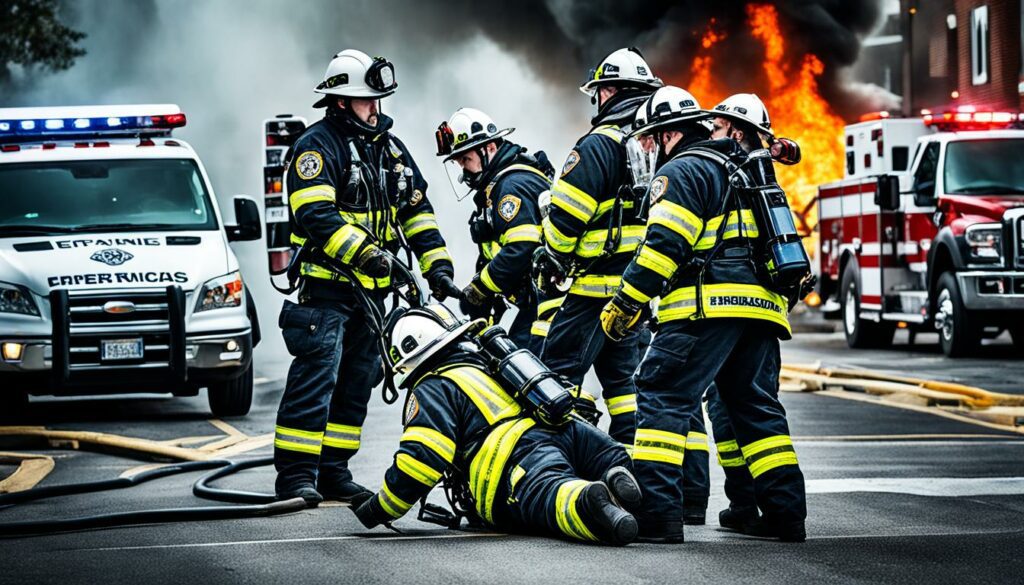
The COVID-19 outbreak demanded quick responses. Task forces, like the one in Greenbrier County, proved invaluable. They shared data fast and acted where needed the most. This teamwork made distributing medical items, vaccines, and ensuring public safety smoother. Their success story teaches us how to do better in future health crises, making our communities safer.
| Incidents | Location | Casualties | Impact |
|---|---|---|---|
| Hurricanes | Coastal Alabama | Multiple | Increased resilience through compliance with building codes |
| COVID-19 Pandemic | Greenbrier County | Programme effectiveness | Optimal resource mobilisation and data-driven response |
From preparing for hurricanes in Alabama to the action-ready COVID-19 Task Force in Greenbrier County, these studies show us the value of working together. Following the best ways of emergency coordination helps us win at keeping our communities safe. This is essential for dealing with crises in the future.
Local first responder partnerships are key for quick and organised emergency responses. It’s important to build strong ties and make official agreements. These steps boost how well emergency scenes are managed.
It’s essential for EMS, police, and aid groups to build strong bonds. These relationships help in sharing info and help smoothly during tough times. Having a good working team, especially in the country, tackles challenges better.
The Greenbrier County COVID-19 Task Force in West Virginia showed the power of working together. Ten sectors from the local community joined forces, including health groups. Their teamwork showed how vital a united front is in hard times.
Making agreements clear with MOUs and legal steps helps a lot. Everyone knows what to do when roles are defined. This was clear in Grundy County, Illinois, during a lithium battery fire. Local and federal teams, like FEMA, worked together smoothly to keep people safe.
Private and public groups coming together helps in managing emergencies. Local shops making necessary items showed the power of these combos. Faith groups, supported by Homeland Security, also pitch in to make community safety stronger.
| Sector | Role |
|---|---|
| Emergency Managers | Coordinate overall response |
| Epidemiologists | Watch and study health data |
| Medical Officers | Offer medical advice and help |
| Law Enforcement | Keep the peace and safe |
| EMS | Provide urgent medical care |
| Humanitarian Organisations | Help and support affected people |
Staying up-to-date with the latest practices and going to workshops helps partnerships work better. National groups and the Federal Highway Administration’s efforts are key.
Getting ready for big emergencies is key to keeping our community strong and safe. It involves working together to spot risks and making plans to face them. This way, we can act fast and work better when troubles hit.
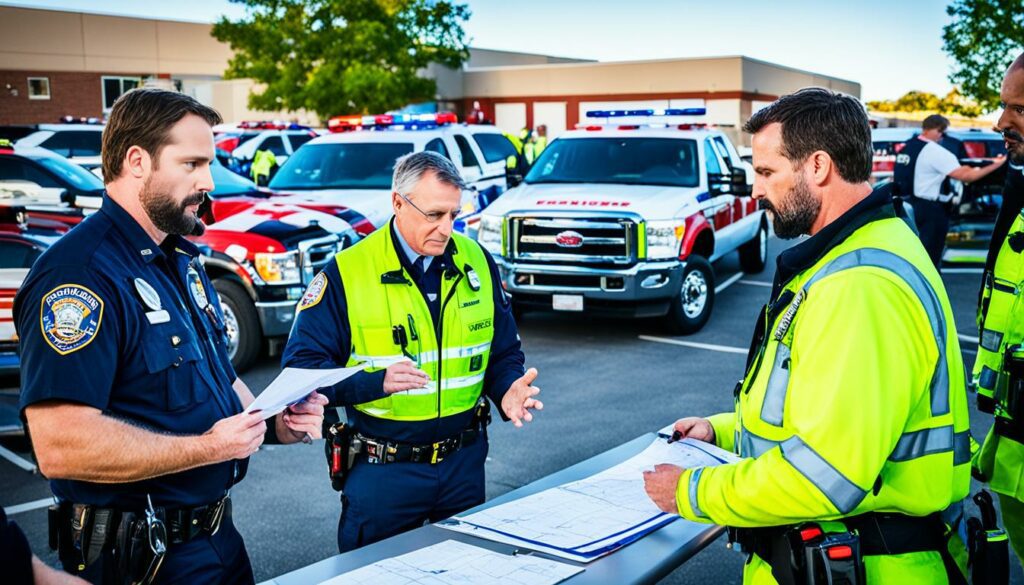
By looking at dangers with the help of emergency teams, we prepare better. This information guides our plans, ensuring we think of every risk. Everyone from local to state groups join in, so we cover all our bases.
Planning our response carefully includes checking our resources and rules. We look at what we have and what we need in a crisis. Making sure we follow the law means our plans are solid and can work for everyone.
| Key Aspect | Statistical Indicator |
|---|---|
| Response Time Assessment | Vital for facility planning and ensuring quick emergency response |
| Resource Evaluation | Capabilities assessment of internal and external systems and personnel |
| Regulatory Compliance | Analysis of applicable emergency planning regulations |
| Training and Exercise | Statistics on trained personnel and exercise frequencies |
| Risk Assessment | Data on potential hazard or threat scenarios |
Training and practice help us do our jobs well when real trouble comes. They improve how we work together and get ready for emergencies. Our goal is to be quick and smart at protecting our communities.
Cooperating with nearby emergency bodies is key to good emergency management. This means working together with local and far-off groups to prepare better and use resources wisely.
Working with many agencies is essential for managing emergencies. With strong tools for sharing information, like WebEOC, we save more lives. This allows quick sharing of important data during crises, improving resource use.
After Hurricane Katrina, we learned the hard way about communication’s vital role. Through solutions like WebEOC, made by Juvare, people from various groups can quickly make choices in tough times.
States working together helps emergency preparation. They share ideas and resources, making everyone more ready. Bodies like the Red Cross and the National Guard lend a big hand when needed.
Nationally, big organisations like the U.S. Department of Health and FEMA offer key aid. Groups like the American Hospital Association also play a big part in joining these efforts.
| Agency | Role | Examples |
|---|---|---|
| Local Government | Primary Safety Management | Police, Fire Departments |
| Emergency Medical Services | Medical and Health Response | EMS, Hospitals |
| Federal Agencies | National-Level Support | FEMA, HHS, USPHS |
| Non-Profit Organisations | Community Support and Recovery | Community Foundations, Humanitarian Orgs |
Joining forces in emergency management is crucial. It brings varied skills and resources under one roof for a faster, more effective crisis response.
The community’s role in emergency services is vital. Local governments working on disaster responses see big benefits from residents getting involved. This includes groups from faith-based organisations to private companies. They make risk assessments and responses better.
Volunteers are key to how communities help in emergencies. The FEMA CERT programme trains them for disaster response. So, they’re ready to help when disasters strike. For example, in Wisconsin’s Derecho Windstorm, these volunteers were a huge help.
The Bomb Cyclone Flood in Nebraska also showed how vital volunteers are. Groups like the Red Cross and the Medical Reserve Corps offer free training. This keeps a strong team of volunteers ready to assist in any emergency.
Local businesses are also very important in managing emergencies. Their involvement increases the help available and ensures a wide-reaching response. They sign up for mutual aid and join in with other groups. This was visible in events like floods.
Further, businesses help with rebuilding and preventing future disasters. Working together, authorities, volunteers, and businesses create a strong emergency response system. They aim to make society safer and more ready for disasters.
Working together with local emergency services is key to a fast and effective disaster response. This teamwork uses the knowledge and tools of many groups to keep damage low and save lives.
It helps the different emergency teams to work well together. This makes our community safer and helps us manage during hard times.
Good coordination means making the right decisions quickly when disaster strikes. It lets us use our resources well and keeps things running smoothly.
It boosts our ties with the people who are first to help in an emergency. This teamwork ensures the safety of everyone in our area.
Local government, charities, businesses, and private groups are all important partners. They come together during an emergency to plan and help out.
These partners work with the emergency teams to make plans, deal with problems, and help us recover after.”
Getting and sharing facts quickly is crucial for making the right moves. Tools like WebEOC help to share information fast, which is key for managing crises well.
Training together and setting things down in writing through MOUs can really help. This makes sure everyone knows what to do, and how to do it, when something bad happens.”
Natural and human-caused disasters need us to work together. Coordinating well improves how we respond, keep each other safe, and handle emergencies.”
Technology helps us communicate and work together quickly when disaster strikes. It’s essential for reaching out to others and using tech to solve problems fast.”
Challenges include not being able to talk well and not having enough resources. Working to fix these issues improves how we can respond to emergencies successfully.”
Good examples are the hurricane and COVID-19 plans. They show us how to work together for the best results and keep everyone safe.
Making friends and setting things down in writing, like with MOUs, helps in getting ready. These actions help our local workers to come together fast and well when needed.”
Doing risk checks together and making detailed plans are vital. These steps help us be ready and act fast during tough times. They are key for our safety.”
By working as a big group and signing deals with others close by, we can be better prepared. This helps us all to work together in tough times.”
Local help and businesses are very important during emergencies. Bringing in different community groups makes us stronger in dealing with crises. It’s about everyone pitching in to help out and keep things going.”